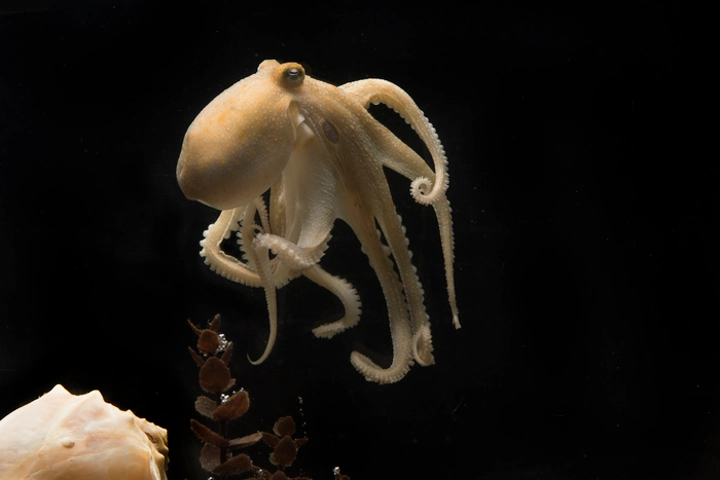

Study of California Two spot octopus revealed that release of chemicals from optic glands is what causes them to hurt themselves (Pic. Courtesy smithsonianmag.com)
<p>
<strong>Like any other mother, the female octopus is protective of her eggs. Guarding them day and night, she zealously shields them from predators while ensuring they remain oxygenated by blowing water over them.</strong></p>
<p>
Yet, a report in smithsonianmag.com stated that a mother octopus is different as unlike other mums, she ceases to eat and worse self-destructs and inflicts injury to herself &ndash; tearing her skin, beating herself against rock and eating her arms. Finally, she dies before getting to see the eggs hatch!</p>
<p>
Till now what the octopus experts knew was that the optic glands of the creature were accountable for this peculiar conduct. This was confirmed since the removal of these glands saw the octopus start eating and living longer.</p>
<p>
Yet, what was fascinating was how did these glands trigger such amazing and strange actions?</p>
<p>
<iframe allow="accelerometer; autoplay; clipboard-write; encrypted-media; gyroscope; picture-in-picture" allowfullscreen="" frameborder="0" height="315" src="https://www.youtube.com/embed/YzjL2D7r6s8" title="YouTube video player" width="560"></iframe></p>
<p>
There were several theories to explain the behaviour including that the death in this dramatic fashion kept the predators away from the eggs. Another suggested that by dying, the mother released nutrients in the water that helped to nurture the eggs. Yet, another contemplated that this self-killing protected the babies from the older generation &ndash; who being cannibals would end up eating up each other&rsquo;s young if they stuck around.</p>
<p>
In a study &ndash; published in Current Biology &ndash; scientists point out that these self-destructive alterations could be ascribed to a set of biochemical pathways that take place following the mating by the octopus. Among them are a spike in 7-dehydrocholesterol (7-DHC), which is a precursor to cholesterol.</p>
<p>
In a statement, highlighting this aspect, Z. Yan Wang, the study&rsquo;s lead author said: <a href="https://www.smithsonianmag.com/smart-news/scientists-figure-out-why-female-octopuses-self-destruct-after-laying-eggs-180980088/?utm_source=smithsoniantopic&amp;utm_medium=email&amp;utm_campaign=20220522-weekender&amp;spMailingID=46859370&amp;spUserID=MTI4MDgxMTczNjcwMgS2&amp;spJobID=2242131820&amp;spReportId=MjI0MjEzMTgyMAS2" rel="nofollow">&ldquo;We know cholesterol is important</a> from a dietary perspective, and within different signalling systems in the body too. It&rsquo;s involved in everything from the flexibility of cell membranes to production of stress hormones, but it was a big surprise to see it play a part in this life cycle process as well.&rdquo;</p>
<p>
Wang is a psychology and biology professor at the University of Washington.</p>
<p>
Wang along with her colleagues closely looked at the chemicals which the optic glands of California two-spot octopuses (Octopus bimaculoides) produced following the laying of eggs. They also examined the optic lobes and glands of unmated females. In their paper, the researchers elaborated on the three chemical pathways which caused a hike in the hormones after reproduction. While in the first pathway, pregnancy hormones were produced, in the remaining two, 7-DHC and bile acid intermediates, were created. Incidentally, both these were not known earlier to be associated in semelparity &ndash; that is those creatures which reproduce or breed once in a lifetime.</p>
<p>
Praising the study, Roger T. Hanlon who is a senior scientist at the Marine Biological Laboratory in Woods Hole, Massachusetts told New York Times: &ldquo;This is an elegant and original study that addresses a longstanding question in the reproduction and programmed deaths of most octopuses.&rdquo;&nbsp; Hanlon was not part of this study.</p>
<p>
The action of destroying itself by octopuses is bizarre as animals like them which have large brains tend to live longer.</p>
<p>
Co-author of the study, Clifton Ragsdale in a statement remarked: &ldquo;What&#39;s striking is that they go through this progression of changes where they seem to go crazy right before they die. Maybe that&#39;s two processes, maybe it&#39;s three or four. Now, we have at least three apparently independent pathways to steroid hormones that could account for the multiplicity of effects that these animals show.&rdquo; Teaching in the University of Chicago, Ragsdale is a professor of neurobiology.</p>
<p>
Remarkably, some of the cholesterol-producing pathways are found in rodents and mammals. Among human beings, the presence of higher-than-normal levels of 7-DHC are toxic and indicate Smith-Lemli-Opitz syndrome (SLOS) &ndash; a genetic disorder. Elaborating on this the statement said that a variation in the enzyme that converts 7-DHC to cholesterol triggers the disorder and this can result in self-injurious behaviour in children.</p>
<p>
On this aspect, Wang told New Scientist: &ldquo;The important parallel here is that what we see in humans, as well as in octopuses, is that high levels of 7-DHC are associated with lethality and toxicity. And that, to me, is really interesting, just because of how evolutionarily divergent these two animals are.&rdquo;</p>
<p>
<strong>Also read: <a href="https://www.indianarrative.com/science-news/female-octopuses-repel-amorous-males-by-flinging-debris-and-shells-111913.html">Female octopuses repel amorous males by flinging debris and shells!</a></strong></p>
Russia's Ambassador to the United Nations, Vassily Nebenzia, sharply criticised the United States for its…
Iran's Ambassador to the United Nations, Amir Saeid Iravani, on Sunday accused Israel of sabotaging…
United Nations Secretary-General Antonio Guterres made an impassioned plea for peace during an emergency special…
The Indian government has scheduled three additional evacuation flights from Iran over the next two…
Australia's High Commissioner to India, Philip Green OAM, called Yoga one of India's gifts to…
The Bharat Sanchar Nigam Limited (BSNL) has announced the soft launch of BSNL Quantum 5G…